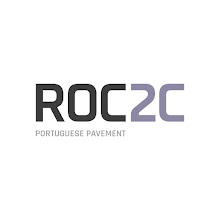News: A Calçada à Portuguesa está a ficar mais moderna (The Portuguese Pavement is getting more modern)
Information QR Code in Chiado, Lisbon
YOU HAVE JUST SCANNED THE FIRST QR CODE IN THE WORLD MADE IN PORTUGUESE COBBLESTONE
HISTORY

Source: www.boasnoticias.pt and http://qrcalcadaportuguesa.com/chiado/
Roc2c is available to perform work on the sidewalk Portuguese with Innovative QR codes
Information QR Code in Chiado, Lisbon
YOU HAVE JUST SCANNED THE FIRST QR CODE IN THE WORLD MADE IN PORTUGUESE COBBLESTONE
HISTORY
Hi, welcome to Chiado, the heart of
Lisbon. At this precise moment you are stepping in Portuguese Pavement,
original from Portugal ordered by his majesty, King Manuel I around 1500.
The King's Letters in the 20th of August 1498 and in the 8th of May 1500 marked the beginning of this type of paving. The Portuguese Pavement was first done in Lisbon, more notoriously at the Rua Nova dos Mercadores.
The art of paving streets, with irregularly shaped coloured stones, results in decorative patterns, enhanced by the contrast between the pale limestone and black basalt used to form the shapes and styles.
This pavement concept came to life with a certain romantic mentality, where national values should be highlighted in a quest for our past symbols, facts and myths that we consider to be fundamental and defining of the Portuguese history and our national identity.
Diverse Portuguese patterns, figures and decorative elements, associated with social and economical activities (fish, fruits, cereals animals amongst others), typical craftwork and elements from the time of the Portuguese Discoveries (ships, mermaids, ropes, sea shell's, waves and stars and armillary spheres) are used in this type of pavement. Portuguese Pavement rapidly spread all over the country and colonies, and as the craft got perfected so did the art. Authentic master pieces were being crafted in these walking pavements. At this point, the Portuguese craftsmen and their art were requested abroad. In their international ventures they worked and taught how Portuguese Pavements was done.
Today, in the XXI century, this centennial art blends with the most innovative and modern technology to inspire you for a new experience.
The King's Letters in the 20th of August 1498 and in the 8th of May 1500 marked the beginning of this type of paving. The Portuguese Pavement was first done in Lisbon, more notoriously at the Rua Nova dos Mercadores.
The art of paving streets, with irregularly shaped coloured stones, results in decorative patterns, enhanced by the contrast between the pale limestone and black basalt used to form the shapes and styles.
This pavement concept came to life with a certain romantic mentality, where national values should be highlighted in a quest for our past symbols, facts and myths that we consider to be fundamental and defining of the Portuguese history and our national identity.
Diverse Portuguese patterns, figures and decorative elements, associated with social and economical activities (fish, fruits, cereals animals amongst others), typical craftwork and elements from the time of the Portuguese Discoveries (ships, mermaids, ropes, sea shell's, waves and stars and armillary spheres) are used in this type of pavement. Portuguese Pavement rapidly spread all over the country and colonies, and as the craft got perfected so did the art. Authentic master pieces were being crafted in these walking pavements. At this point, the Portuguese craftsmen and their art were requested abroad. In their international ventures they worked and taught how Portuguese Pavements was done.
Today, in the XXI century, this centennial art blends with the most innovative and modern technology to inspire you for a new experience.

Source: www.boasnoticias.pt and http://qrcalcadaportuguesa.com/chiado/


Comentários
Enviar um comentário